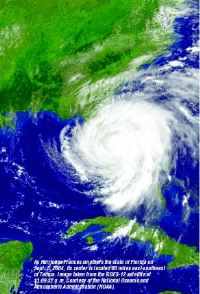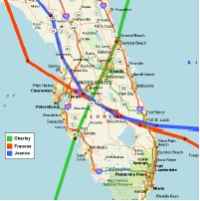Streamlined Services Sustain Sunshine State’s Survival
Streamlined Services Sustain Sunshine State’s Survival
Following a season of record-breaking storms, Florida recovers and rebuilds with support from many sectors
 |
 |
|
The paths of Hurricanes Charley, Frances, and Jeanne crossed over Polk County, FL, southwest of Orlando, in 2004. Image courtesy of Skeetobite.com. |
Florida in September 2004 was a disaster scene of epic proportions. Three major hurricanes targeted the center of the state as ground zero, and a fourth hurricane and a tropical storm battered the Panhandle. Not since Texas in 1886—118 years before— had four hurricanes struck the same state in a single season and with such destructive power.
For nearly six weeks beginning in mid-August, wave after wave of wind and water demolished homes and businesses, eroded beaches, and flooded communities, destroying power grids, damaging infrastructure, and virtually halting commerce.
Total damages for the season’s combined 27 major federal disaster declarations in Florida and 14 other states, Puerto Rico, and the U.S. Virgin Islands eventually may top $42 billion, displacing 1992’s Hurricane Andrew as the costliest and most destructive natural disaster ever in the United States. Insured losses could surpass $23 billion.
As of Nov. 30, the official end of the 2004 Atlantic hurricane season, federal and state disaster relief had reached the $4.27 billion mark and could climb over $8 billion. Florida alone had received $3.11 billion in aid. The Sunshine State’s recovery will take years.
Pre-Plan, Pre-Stage, and Pre-Deploy
The immediate problems facing Florida’s Department of Community Affairs’ Division of Emergency Management (DEM) and the U.S. Department of Homeland Security’s Federal Emergency Management Agency (FEMA) were unprecedented and statewide: shelter, water, food, power, communications, and emergency services. President George W. Bush eventually issued major disaster declarations for all of Florida’s 67 counties.
But DEM mobilized as first Tropical Storm Bonnie and then Hurricane Charley targeted the Gulf Coast. Department of Community Affairs’ Eve Rainey, Chief, Bureau of Compliance Planning and Support, says the state was ready because DEM had built upon lessons learned from Hurricane Andrew in 1992 and from other disaster emergencies over the years, including the Gulf Coast’s hurricane-force, No-Name Storm of March 1993, severe fire seasons, and several floods.
“Prior to and during Andrew, we were very much organized by state agency, what we call a government-centric approach,” she says. “We limited ourselves to using governmental responses.” It was up to the DEM staff to know what departments had what government assets. “Following Andrew, we realized we had to order ourselves differently, so we’d have like people and agencies and organizations working functionally together to solve problems.”
Rainey says that FEMA helped inspire that decision. “Right as Andrew was coming at us, literally, [FEMA] had first published the federal response plan. [It] was the first time that federal agencies were organized in the more functional approach.”
FEMA’s plan established 12 emergency support functions— transportation, communications, public works and engineering, firefighting, information and planning, mass care, resource support, health and medical services, urban search and rescue, hazardous materials, food, and energy—as a framework for coordinating delivery of federal disaster assistance to state and local governments, with federal agencies working together to achieve the common goal of efficient, timely, and consistent disaster response and recovery.
“We adopted the [federal response] concept after Hurricane Andrew. We actually did 16 emergency support functions [and] have since added a 17th for animal and agricultural issues,” Rainey says. “Our first 12 match up with the federal plan.”
The state specifically added Resource Support, which Rainey sees not just as procurement but more as identifying where the resources are, and a Logistics section that helps organize procurement and distribution and even recoups resources when they are no longer needed. Using this system, the state can organize pre-deployment before an emergency event and not wait until after a disaster happens to decide what’s needed in the affected area. Preestablished sets of standard packages—food, water, ice; comfort stations with portable toilets, showers, and more; base camps; and staging areas—can be deployed as turnkey operations. The state negotiates with a contractor or a vendor to supply a total package, to help set it up, and even to help manage it.
Rainey notes that another big change has been to encompass private-sector expertise and assets, private nonprofit and volunteer agencies, organized and trained volunteers, and citizen groups that also support the relief effort.
Florida’s emergency response system works for all hazards, from natural disasters to homeland security. The state’s approach to procurement and its concept of operations did not change significantly after 9/11. “What changed the most,” says Rainey, “was the concept of competing with many other entities in the event of an incident that affected multiple widespread geographic areas simultaneously, as well as an incident that may potentially affect a national transportation system to move commodities.”
Rainey acknowledges that events such as 9/11 are much different from a hurricane scenario, but she says the state is organized to deal with whatever might happen. ” Predeployment and pre-negotiated contracts—anything you can do before something happens—is much higher in our thought process.”
Mobilize and Monitor
State purchasing, in association with DEM, began to gear up for the predicted hurricane season in early May, according to Cyndee Sams, Training and Certification Consultant and Emergency Coordinating Officer for the Division of State Purchasing, Department of Management Services.
At that time, the division assembled a purchasing volunteer list from all state agencies. But after both Bonnie and Charley made landfall within days in August, the team quickly recognized that the initial list of volunteers would not be able to handle the workload.
“At the Purchasing Director’s meeting in August,” says Sams, “andicted-other call went out to the various state agencies requesting volunteers.” Several agencies volunteered their employees’ service to the State Emergency Operation Center (SEOC) and even offered to have them travel to the hurricane-damaged areas to assist the local purchasing divisions.
As other hurricanes lined up in the Atlantic, the scenario unfolded rapidly. DEM ordered residents and visitors to evacuate areas in the predicted paths. County emergency management agencies declared local states of emergency. DEM monitored the situation on standby ready to assist, then recommended that Governor Jeb Bush issue an executive order authorizing state agency resources to assist. This order relaxed certain purchasing and budgeting requirements such as checks and balances in order to expedite delivery of services.
As the next step, Governor Bush requested that President Bush issue a major presidential disaster declaration, which in turn would expedite emergency responses from both federal and state agencies and enable direct access to federal resources. Four such presidential declarations were issued overall affecting the entire state.
FEMA and its state counterparts often worked together in the same operations centers.
“We tried to organize the system on a day-to-day-basis to be similar enough that when we had to work together, we spoke the same language and had compatible procedures and processes for a unified command and response,” explains Rainey.
Florida also activated the Emergency Management Assistance Compact (EMAC), the legislated mutual aid agreement and partnership between states that allows the entities to send personnel and equipment to help disaster relief efforts in other states.
“The state utilized EMAC to have additional logistics/procurement personnel come to Florida and assist us,” says Jeff Milligan, Emergency Coordinating Officer, Department of Management Services.
Adopted by the southern governors after Hurricane Andrew in 1992 for mutual aid in times of disaster, EMAC was approved by Congress in 1996 as a public law and subsequently ratified by 48 states, the territories of Puerto Rico and the U.S. Virgin Islands, and the District of Columbia. “[Activating EMAC] was necessary for increased staffing based on the magnitude of the event,” Milligan says.
Recover and Rebuild
Florida’s recovery phase will be ongoing until all systems return to normal or as close to normal as possible. The mobilization alert, which began before Tropical Storm Bonnie hit the Panhandle on Aug. 11 and sustained its highest level of activation until the first week in November, now stands at low. However, monitoring the misery left behind continues.
FEMA and Florida’s State Emergency Response Team (SERT) still are working to provide safe and clean emergency housing for residents originally displaced by the storms or now forced to move because of developing mold and mildew problems. FEMA continues to keep open the application period for those people who are just now recognizing eligible damage. The deadline has been extended to Dec. 31 for all four events.
Rebuilding whole communities likewise will take years.
Rainey boasts that by now Florida’s emergency response team is probably the most experienced emergency response team in the world. Faced with unprecedented challenges, the team continuously finds new ways to apply nontraditional solutions with the resources at hand, such as satellite tracking of equipment in the field, and moving fuel supplies by rail (see “Logistics Team Partners With Rail Transporter to Get Critical Fuel Flowing to the Field,” pg. 15).
Lessons Learned
The key to a successful emergency response plan, Rainey explains, is to have procurement at the lowest level closest to the need.
“Each state agency has delegated authority for procurement,” she says. “In the State Emergency Operations Center (SEOC) environment, agencies and organizations are organized functionally and each utilizes its own delegated authority for day-to-day procurement.”
This allows the SEOC to activate Emergency Support Functions (ESFs) for pre-staging of resources before a storm hits. “For hurricanes,” says Milligan, “we like to activate and pre-stage resources three to four days prior to landfall.”
The state also has inter-and intragovernmental mutual aid agreements, both formal and informal, that enable cities and counties to borrow resources from each other or from the state and use them without procuring them—standard practice among law enforcement, fire, and public works jurisdictions.
Although the system has worked better than imagined, Rainey notes there always will be room for improvement. Under consideration are moves to expand logistics resources and expertise, additional negotiated contracts, purchasing and predeployment of resources, regional caches of commodities, and technology solutions for resource tracking.
“State Purchasing is beginning to collect lessons learned and look at commodities and services that were hard to obtain during the disaster,” reports Sams.
The recovery effort enacted by Florida’s emergency response team in the wake of the storms of 2004 demonstrates that the state has a network of proven vendor relationships, yet Milligan would like to see more flexibility among the vendors. “We’ve got some challenges [ remaining] with emergency housing needs and reconstruction,” Rainey admits. “But with the traditional programs that we implement postdisaster, I think we’re pretty much in step with where we should be at this point.”
Rainey summarizes that Florida’s emergency response system has experienced many firsts this year. “Our system is designed to be structured so you can respond with the amount of resources and assets and people that you need depending on the size of the event,” Rainey says. “Every single day we look for opportunities to make it better.”
Logistics Team Partners With Rail Transporter to Get Critical Fuel Flowing to the FieldFlorida ports were closed off and on for weeks due to the number, severity, and unpredictability of the four major hurricanes. While there was no actual shortage of fuel, there were logistic problems in its distribution. Without electricity, the normal fueling sites for both the trucking industry and the public were inoperable. Fuel tender (a tanker truck with self-pumping capabilities) drivers were unwilling to remain in the state faced with multiple threats of other storms, the evacuating population, debris, and the inconvenience of life without power. After Hurricane Frances passed, “We were without fuel,” says Donna Smith, Purchasing Specialist with Florida’s Department of Management Services. “Millions of gallons of diesel and unleaded fuel stored throughout the state were inaccessible due to the lack of transport—fuel much needed for the search and rescue teams, the National Guard, the Red Cross, and other emergency response vehicles.” Smith’s Logistics team called trucking companies across the southeast and got a variety of responses, but not one was willing to risk rig and driver until the storm danger had passed. Smith and Vince Velasquez, Emergency Response Technician with the O’Brien Group, a logistics contractor based in Houston, TX, discussed the idea of using rail transport. With a train delivering to a central depot, the Logistics group could use local men with tender trucks to disperse the fuel. How could they get a train into an evacuated, devastated state, they wondered. Smith and Velasquez launched Internet searches by railway name, fuel types, state, and region. Realizing that railroads operate 24/7—someone must be on call for repairs or emergencies—they located a list of CSX Corp. (Jacksonville, FL) station managers’ cell phone numbers. Late on a Saturday evening they divided the list and left messages for every number they called. The following Sunday morning, Velasquez received a call from a high-ranking official at CSX who was eager to assist. By that afternoon, a train and crew had been assembled. The train left Texas Sunday evening and arrived in Jacksonville late Monday morning. The fuel was loaded, and the train made its delivery to a depot in Sanford, FL. From that centralized location, tenders would take on and distribute fuel to the semis (delivering water, ice, and Meals, Ready-To-Eat [MREs]), fire trucks, ambulances, police vehicles, and other vital service operations until power and normal distribution channels could be restored. “The folks at CSX were really responsive,” says Smith. “Everyone we phoned returned our calls and was pleased that their organization’s assistance was very much appreciated.” |
Disaster Aid for Florida’s Recovery Tops $3.1 BillionMoney to help Floridians affected by the four major hurricanes that swept through the state in August and September continues to flow. Federal and state aid surpassed $3.11 billion as of Nov. 30, with more than 1.16 million of the state’s residents seeking recovery assistance for losses suffered from Hurricanes Charley, Frances, Ivan, and Jeanne, as well as from Tropical Storm Bonnie. All 67 of Florida’s counties are affected by disaster declarations. By the numbers:
|
Editor’s Note: Eve Rainey is the Chief, Bureau of Compliance Planning and Support, in the State of Florida’s Department of Community Affairs, Tallahassee. Jeff Milligan, Emergency Coordinating Officer, Department of Management Services, serves as Deputy Section ChiefLogistics/ESF 7 at the State Emergency Operations Center. Cyndee Sams serves as Training and Certification Consultant and Emergency Coordinating Officer for the Division of State Purchasing, Department of Management Services.




















